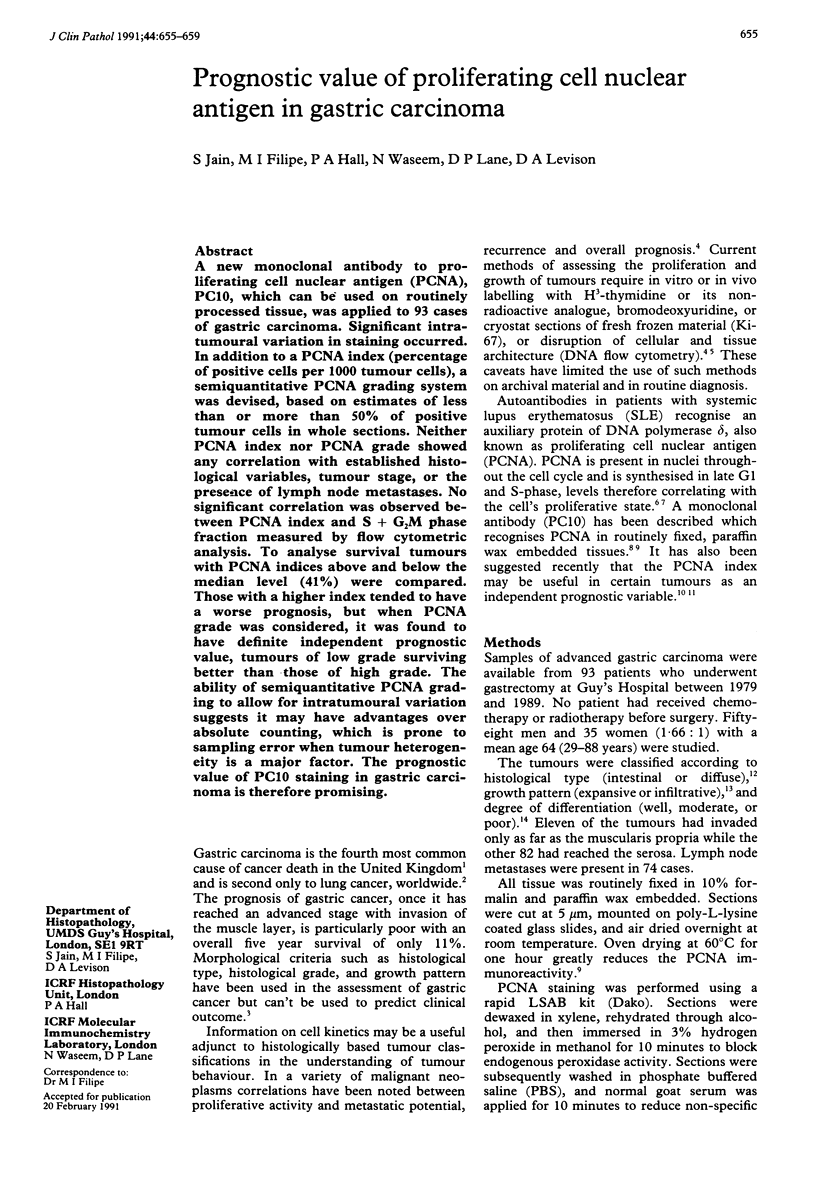Abstract
A new monoclonal antibody to proliferating cell nuclear antigen (PCNA), PC10, which can be used on routinely processed tissue, was applied to 93 cases of gastric carcinoma. Significant intra-tumoural variation in staining occurred. In addition to a PCNA index (percentage of positive cells per 1000 tumour cells), a semiquantitative PCNA grading system was devised, based on estimates of less than or more than 50% of positive tumour cells in whole sections. Neither PCNA index nor PCNA grade showed any correlation with established histological variables, tumour stage, or the presence of lymph node metastases. No significant correlation was observed between PCNA index and S + G2M phase fraction measured by flow cytometric analysis. To analyse survival tumours with PCNA indices above and below the median level (41%) were compared. Those with a higher index tended to have a worse prognosis, but when PCNA grade was considered, it was found to have definite independent prognostic value, tumours of low grade surviving better than those of high grade. The ability of semiquantitative PCNA grading to allow for intra-tumoural variation suggests it may have advantages over absolute counting, which is prone to sampling error when tumour heterogeneity is a major factor. The prognostic value of PC10 staining in gastric carcinoma is therefore promising.
Full text
PDF




Images in this article
Selected References
These references are in PubMed. This may not be the complete list of references from this article.
- Bouzubar N., Walker K. J., Griffiths K., Ellis I. O., Elston C. W., Robertson J. F., Blamey R. W., Nicholson R. I. Ki67 immunostaining in primary breast cancer: pathological and clinical associations. Br J Cancer. 1989 Jun;59(6):943–947. doi: 10.1038/bjc.1989.200. [DOI] [PMC free article] [PubMed] [Google Scholar]
- Filipe M. I., Rosa J., Sandey A., Imrie P. R., Ormerod M. G., Morris R. W. Is DNA ploidy and proliferative activity of prognostic value in advanced gastric carcinoma? Hum Pathol. 1991 Apr;22(4):373–378. doi: 10.1016/0046-8177(91)90085-4. [DOI] [PubMed] [Google Scholar]
- Hall P. A., Levison D. A. Review: assessment of cell proliferation in histological material. J Clin Pathol. 1990 Mar;43(3):184–192. doi: 10.1136/jcp.43.3.184. [DOI] [PMC free article] [PubMed] [Google Scholar]
- Hall P. A., Levison D. A., Woods A. L., Yu C. C., Kellock D. B., Watkins J. A., Barnes D. M., Gillett C. E., Camplejohn R., Dover R. Proliferating cell nuclear antigen (PCNA) immunolocalization in paraffin sections: an index of cell proliferation with evidence of deregulated expression in some neoplasms. J Pathol. 1990 Dec;162(4):285–294. doi: 10.1002/path.1711620403. [DOI] [PubMed] [Google Scholar]
- Hedley D. W., Friedlander M. L., Taylor I. W., Rugg C. A., Musgrove E. A. Method for analysis of cellular DNA content of paraffin-embedded pathological material using flow cytometry. J Histochem Cytochem. 1983 Nov;31(11):1333–1335. doi: 10.1177/31.11.6619538. [DOI] [PubMed] [Google Scholar]
- LAUREN P. THE TWO HISTOLOGICAL MAIN TYPES OF GASTRIC CARCINOMA: DIFFUSE AND SO-CALLED INTESTINAL-TYPE CARCINOMA. AN ATTEMPT AT A HISTO-CLINICAL CLASSIFICATION. Acta Pathol Microbiol Scand. 1965;64:31–49. doi: 10.1111/apm.1965.64.1.31. [DOI] [PubMed] [Google Scholar]
- Mathews M. B., Bernstein R. M., Franza B. R., Jr, Garrels J. I. Identity of the proliferating cell nuclear antigen and cyclin. Nature. 1984 May 24;309(5966):374–376. doi: 10.1038/309374a0. [DOI] [PubMed] [Google Scholar]
- Ming S. C. Gastric carcinoma. A pathobiological classification. Cancer. 1977 Jun;39(6):2475–2485. doi: 10.1002/1097-0142(197706)39:6<2475::aid-cncr2820390626>3.0.co;2-l. [DOI] [PubMed] [Google Scholar]
- Peto R., Pike M. C., Armitage P., Breslow N. E., Cox D. R., Howard S. V., Mantel N., McPherson K., Peto J., Smith P. G. Design and analysis of randomized clinical trials requiring prolonged observation of each patient. II. analysis and examples. Br J Cancer. 1977 Jan;35(1):1–39. doi: 10.1038/bjc.1977.1. [DOI] [PMC free article] [PubMed] [Google Scholar]
- Prelich G., Tan C. K., Kostura M., Mathews M. B., So A. G., Downey K. M., Stillman B. Functional identity of proliferating cell nuclear antigen and a DNA polymerase-delta auxiliary protein. Nature. 1987 Apr 2;326(6112):517–520. doi: 10.1038/326517a0. [DOI] [PubMed] [Google Scholar]
- Shepherd N. A., Richman P. I., England J. Ki-67 derived proliferative activity in colorectal adenocarcinoma with prognostic correlations. J Pathol. 1988 Jul;155(3):213–219. doi: 10.1002/path.1711550306. [DOI] [PubMed] [Google Scholar]
- Waseem N. H., Lane D. P. Monoclonal antibody analysis of the proliferating cell nuclear antigen (PCNA). Structural conservation and the detection of a nucleolar form. J Cell Sci. 1990 May;96(Pt 1):121–129. doi: 10.1242/jcs.96.1.121. [DOI] [PubMed] [Google Scholar]
- Yonemura Y., Ooyama S., Sugiyama K., Ninomiya I., Kamata T., Yamaguchi A., Matsumoto H., Miyazaki I. Growth fractions in gastric carcinomas determined with monoclonal antibody Ki-67. Cancer. 1990 Mar 1;65(5):1130–1134. doi: 10.1002/1097-0142(19900301)65:5<1130::aid-cncr2820650516>3.0.co;2-a. [DOI] [PubMed] [Google Scholar]



